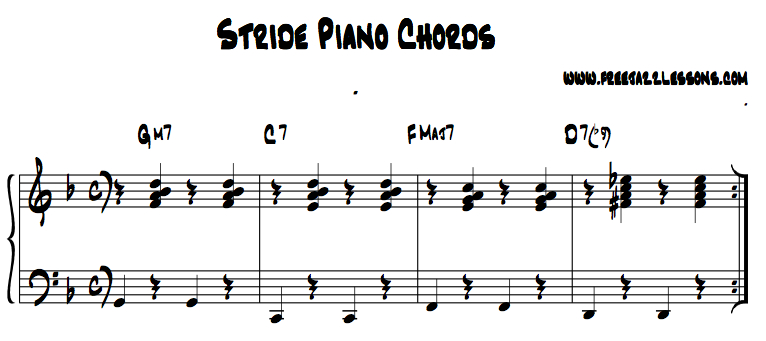Stride Piano Lesson: Free Video and Tips
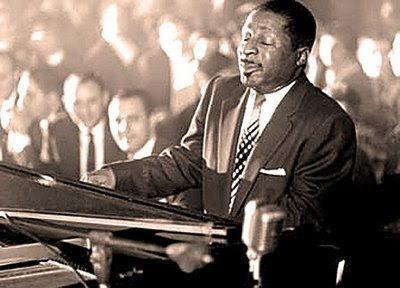 Want some stride piano tips?
Want some stride piano tips?
Would you like to learn more interesting ways of playing your favorite jazz standards and chord progressions on piano?
In today’s jazz piano lesson, we’re going to study a classic rhythmic way of doing this called stride piano. (Video lesson, notation, and tips below.)
This particular style was made famous by many great players like Art Tatum, Oscar Peterson, Willie “The Lion” Smith, James P. Johnson, and Fats Waller.
It’s a very fun style to play, and it can immediately add some variety and sophistication to your jazz piano arrangements.
Plus, it’s not too hard to learn!
Let’s get started learning now! I suggest you watch the video below first and then scroll down for notation and extra tips.
Stride Piano Lesson Notation
Click to expand. Feel free to share on Facebook or Twitter as well. Please credit freejazzlessons.com
8 Tips To Help You Master This Lesson
1. How To Master Rootless Voicings
 Now, the chords I’m using are rootless voicings.
Now, the chords I’m using are rootless voicings.
Rootless voicings seem intimidating at first. However, they’re easy to deal with once you dissect chords.
Rootless Major Chords
First, let’s take a look at a major 7th chord. Let’s use Fmaj7 as an example.
We have the notes F-A-C-E.
Consequently, what we have left are the notes A-C-E, and it is simply an Am triad.
Certainly, applying this technique to other major chords gets the same result.
Therefore, rootless major chords are just minor triads that start on the 3rd.
Now, what about minor chords?
Rootless Minor Chords
Likewise, you can apply the same principle to minor chords.
If you take out the root, what do you get?
Let’s look at a Gm7 chord:
- First, Gm7 has G-Bb-D-F.
- Second, you’ll identify Bb-D-F. It’s a Bb major triad.
If you do this to all other minor chords, you’ll find the same pattern emerging.
Therefore, rootless minor chords are major triads starting at the b3.
So, let’s see how do we deal with dominant chords.
Rootless Dominant Chords
Check this out:
To start, a C7 chord has the notes C-E-G-Bb
After that, take out C: All you have left is E-G-Bb which is an E diminished triad.
Going further, you’ll get the same result if you apply the same idea to other dominant chords.
And thus, all dominant chords have diminished triads from the 3rd as their rootless versions.
The Summary Of All Common Rootless Chord Shortcuts
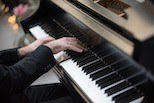 And so, here are shortcuts you can use to play rootless voicings instantly:
And so, here are shortcuts you can use to play rootless voicings instantly:
- Rootless major chords are basically minor triads and derivatives starting on the 3rd.
- For rootless minor chords, use major triads starting on the b3 of the minor chord.
- Rootless dominant 7th chords are diminished triads starting on the 3rd.
- Minor 7th b5 chords when rootless are minor triads starting on the b3.
- Lastly, Dominant 7th (#5) chords are just major triads starting at the 3rd.
If you need more help building these chords, then check out this whole lesson on rootless piano chords.
2. How To Get The Oom-Pah Sound
The basic concept behind stride is a low bass note is played on beats 1 and 3 and chords (toward the center of the piano) are played on beats 2 and 4.
There are a couple ways to play the low bass note, and so here are some examples:
- Play only the root of the chord (as shown in the above example).
- Play the root on beat 1 and then the 5th on beat 3.
- For fast tempos where there’s only one chord over 2 bars, you can use a walking bass pattern for the bass notes. Some jazz legends like Errol Garner would occasionally use that kind of technique.
It’s easy to think of your left hand as a kind of “drummer”.
So, think of the bass notes on beats 1 & 3 as the kick drum of a drum kit and the rootless chords on beats 2 & 4 as the snare.
This way, you can properly accent your left hand stride piano moves.
Now let’s discover other styles of music where you can use stride piano technique.
3. How To Use Stride Piano Technique On Other Tunes & Styles Of Music
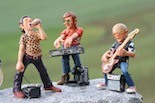 Did you know that you can use stride piano technique in other styles of music?
Did you know that you can use stride piano technique in other styles of music?
Here are some really good examples:
How Stride Piano Was Used In Classical Music
One of the best examples in classical piano canon are Scott Joplin’s works such as Maple Leaf Rag and The Entertainer.
Here’s Scott Joplin’s piano roll recording of “Maple Leaf Rag”:
Influenced by ragtime, Claude Debussy used stride piano technique for “Golliwog’s Cakewalk”:
Erik Satie’s famous pieces called Gymnopedies also feature stride piano technique.
In Gymnopedie No. 1, you hear Gmaj7 and Dmaj7 across 2 bars played stride style but in 3/4:
The bass notes are still played on beat 1 but the rootless chords are held for 2 beats.
Technique similar to stride piano technique is rather abundant in classical repertoire.
However, classical music is not the only other style where stride piano works.
This particular style would even work great on many rock classics, so check out the examples below.
Examples Where Stride Piano Can Be Used In Rock
Rock is another genre of music where stride piano works very well.
This is because most rock music is in 4/4 time with a strong backbeat.
For example, songs like “When I’m 64” by The Beatles or “Bennie and The Jets” by Elton John work well in a stride style.
When I’m 64 is an obvious choice for stride piano in rock.
If you listen to this Beatles hit, you can immediately hear the “oom-pah” groove with some jazz brush drum work. The tune really has that Dixieland feel that can really work well with stride piano.
Elton John’s “Bennie & The Jets” has that slow but strong 4/4 groove:
Another interesting piece that can be arranged in a stride piano arrangement is Eric Johnson’s “Cliffs Of Dover”:
“Cliffs of Dover” really swings, and it would sound great if rearranged into stride piano. The chorus of the song even features a ii-V-I-vi chord progression.
Speaking of songs, how do you pick the right ones to stride on?
4. The Best Places To Use Stride Piano Moves
 You can add the stride piano rhythmic style to almost any jazz standard that’s in 4/4.
You can add the stride piano rhythmic style to almost any jazz standard that’s in 4/4.
In fact, stride piano moves will work on almost any tune in 4/4 time.
This is because you have your low bass notes on beats 1 and 3 and rootless chords on beats 2 and 4.
If you look closely, this is the same as a basic jazz or rock drum groove.
Now let’s look at how to develop speed.
5. How To Speed Up Your Stride Piano Technique
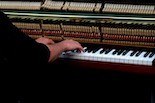 In order to speed up the tempo on stride piano and not drag always remember to keep your hands close to the keyboard.
In order to speed up the tempo on stride piano and not drag always remember to keep your hands close to the keyboard.
In other words, don’t make your leaps broader motions than they need to be. This is because It’s inefficient and cause you to drag your timing.
Another benefit of keeping your hands close to the keyboard is that it improves your accuracy.
By keeping your hands close to the keyboard, you are able to feel the keys using your fingertips.
This way, you’ll have a better idea of where your hands are on the keyboard.
6. How To Use Extended Chords When Playing Stride Piano
 I make use of a lot of extensions for the rootless chords I use in stride piano.
I make use of a lot of extensions for the rootless chords I use in stride piano.
The first chord is actually a G7 with a 9th.
The second chord is a C7 with a 9th and a 13th.
One thing you’ll notice here is the smooth voice leading between all the rootless chords.
The minor 3rd of Gm7(9) becomes the b7 of C7, the 9th becomes the 13th, and the 5th becomes the 9th.
The final chord I play is a D7 chord. I’m using a flat nine as an extension on top, but really you could use any note as an extension from the altered scale.
If you need more help playing extended chords check out this chord extensions lesson.
7. Going Beyond Stride Piano
 Traditional stride piano is only one of the skills you need to work on.
Traditional stride piano is only one of the skills you need to work on.
If you’re playing a set of music, you want to be able to play in other left-hand styles as well.
There are other patterns you can use to make your solo piano arrangements sound more interesting.
Examples of these include walking bass, flowing arpeggios, sparse occasional chords, Bill Evans style comping, and others.
If you need more help learning jazz piano then check out this huge list of other jazz piano lessons
8. How Legends Used Stride Piano In Their Playing
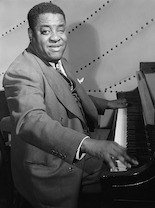 For a super fun and killer example of stride check out this Errol Garner video. It’s sort of an older fashion or “retro” sound but very fun none the less!
For a super fun and killer example of stride check out this Errol Garner video. It’s sort of an older fashion or “retro” sound but very fun none the less!
He starts striding about 27 seconds in.
Another awe-inspiring example of stride piano is Art Tatum playing “Tea For Two”
Art Tatum’s approach to stride piano features a lot of variety, and here are some examples:
- Some of the bars (notably bars 5 and 6) feature shell voicings on beat 1 & 3 (7th and 10th).
- Single bass notes plus rootless chords.
- Spread chords (root + 5th + 10th) on beats 1 and 3 and rootless chords on beats 2 and 4.
So, it’s easy to see that Art Tatum’s virtuosic approach was so influential.
As a result, we find his influence in other stride players like Oscar Peterson.
Oscar Peterson is another monster player that uses stride piano as one of his tools.
To see what I mean, check out this Oscar Peterson piano solo where he strides at 3:17:
Willie “The Lion” Smith is another amazing stride piano. Watch how he varies his rhythm while still keeping the essential stride technique:
Fats Waller easily belongs to the greatest stride piano players in history. So, check out this version of “Ain’t Misbehavin'”:
However, no list of stride piano legends would be complete without James P. Johnson.
After all, his body of work contributed to the popularity of stride piano.
Listen to his composition “Carolina Shout”:
Listen well to how James P. Johnson creates interest in his stride piano playing. After that, try to identify techniques other than stock stride moves.
Now, what are some ways you can do that yourself?
How The Legends Created Variety In Their Stride Piano Playing
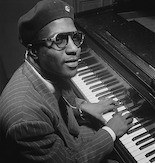 You’ll discover that many jazz piano heroes don’t use stride throughout the entire song.
You’ll discover that many jazz piano heroes don’t use stride throughout the entire song.
Additionally, they will only use stride when a driving “oom-pah” feel is warranted.
While the majority of your tune has that stride piano feel, it’s helpful to break it up in some segments.
And so, Art Tatum, Oscar Peterson, and Errol Garner might mix it up with some things such as:
- Block chord runs.
- Walking bass.
- Left hand arpeggios.
- Octave lead lines for both hands.
- Contrapuntal passages.
And now that you’ve discovered such tricks, how do you go about doing the same thing?
The Best Way To Discover The Tricks Of The Pros
 Are you frustrated that your piano playing falls short of your expectations?
Are you frustrated that your piano playing falls short of your expectations?
Perhaps you have gone through various YouTube videos.
Unfortunately, this makes you more confused than before.
Worst of all, your listeners don’t even care about your playing at all.
What’s the best way to go about it?
Look for mentors that have stage and studio experience because they know exactly what you need to do.
Fortunately, we have such mentors inside the Jazz Inner Circle.
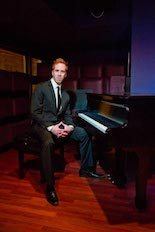 Our Jazz Inner Circle faculty consists of award-winning, Grammy nominated, world touring jazz pianists.
Our Jazz Inner Circle faculty consists of award-winning, Grammy nominated, world touring jazz pianists.
By working with one of our instructors, you can learn their secrets and tricks to play music that turns peoples’ heads.
Inside the Jazz Inner Circle, you’ll discover:
- “The Jazz Piano Mastery Program” (Over $25,000 worth of jazz piano training resources)
- “The Ultimate Jazz Workout Training System.” This is where we implement a complete practice program to build your jazz piano talent in record time.
- Access to over 50 hours of high level jazz intensive workshops.
Therefore, get 1-on-1 jazz piano mentorship from world class pros here.
Now, let me turn the floor over to you: What songs would you like to add stride piano into? What do you think would work great with stride?
If you’re already playing stride what songs are you using it on? Please leave a comment below.
*************
If you enjoyed this lesson, please be sure to subscribe to the freejazzlessons email list. (Right below this article or on the top left). Why?
- Because you’ll receive all the latest and greatest lessons as soon as their published right in your inbox!
- Additionally, you’ll be joining one of the fastest growing jazz education communities online today!

